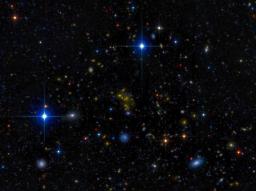
One of the areas of the sky observed by SNLS through the Canada-France-Hawaii telescope Megacam camera. The area shown represents 2% of the total area covered and encompasses some 20,000 galaxies
The Supernova Legacy Survey (SNLS) team at the Canada-France-Hawaii Telescope facility has just obtained the world's best measurement of the explosion rate of massive stars when the Universe was only 10 billion years old. A research team at IRFU's particle physics department at the CEA-Saclay centre worked on the first three years of SNLS data to obtain this result, which makes a crucial contribution to our understanding of the origins and evolution of chemical elements in the interstellar medium. The measurement seems to show that there are two to four times fewer supernovae today than 3.7 billion years ago. Could the Universe be burning out?
Contacts:
Nathalie PALANQUE-DELABROUILLE
• Structure and evolution of the Universe
• The Electronics, Detectors and Computing Division • The Particle Physics Division



